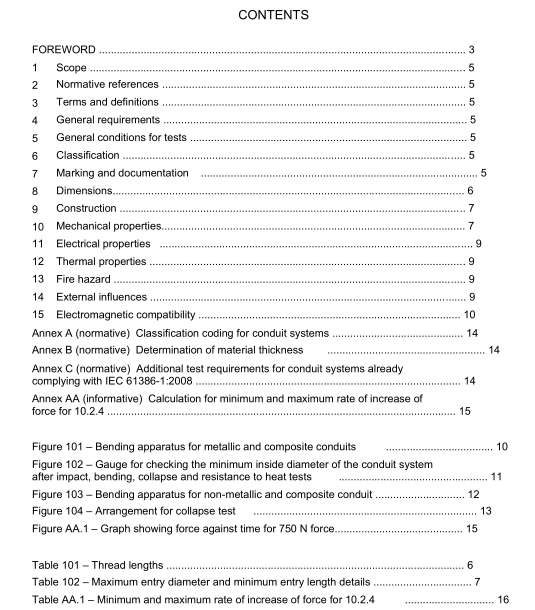IEC 61386-21 pdf – Conduit systems for cable management – Part 21: Particular requirements – Rigid conduit systems

IEC 61386-21 pdf – Conduit systems for cable management – Part 21: Particular requirements – Rigid conduit systems
10.4.101.2 Samples having a length equal to 30 times the nominal diameter, are bent so thatwhen released, they have an angle of (90 ± 5) °, so that the inside radius of the bend is equalto six times the nominal diameter.
10.4.101.3 For conduits with welded seams, six samples are tested, three with the seam onthe outside of the bend, three with the seam on the side.
10.4.101.4After the test:
– the basic material of the conduits and the protective coating of the conduits shall show no
cracks visible to normal or corrected vision without magnification;
– seams, if any, shall not have opened;
– the section of the conduit shall not have distorted unduly.The distortion of the section is checked as follows:
When the bent conduit is held in such a position that the straight portions are at an angle ofapproximately 45° to the vertical,one end of the sample pointing upwards and the otherdownwards, it shall be possible to pass the appropriate gauge as shown in Figure 102 through
the sample under its own weight and without any initial speed.
10.4.102 Non-metallic conduits
10.4.102.1 Conduit sizes 16,20 and 25 are subjected to a bending test by means of theapparatus shown in Figure 103. The length of the sample is 500 mm ±10 mm. Testing ofother sizes is in accordance with the manufacturer’s instructions.
10.4.102.2 A bending aid, in the form of a coiled spring of square section metal wire,without
burrs and having an overall diameter between 0,7 mm and 1,0 mm less than the specifiedminimum inside diameter of the conduit, or a bending aid recommended by the manufacturer,
is inserted into each sample before bending.
10.4.102.3 The sample with the bending aid inserted is conditioned for at least 2 h in arefrigerator within which the temperature is maintained at the declared temperature as givenin Table 1 with a tolerance of +2C.
The test is carried out within 12 s± 2 s after the removal of the sample from the refrigerator.
10.4.102.4 Each sample is placed in position as shown in Figure 103, and held lightly in the
groove of the former by means of the clamp.The sample is bent round the former by movingthe bending rollers so that, when released, it has an angle of (90 ± 5)°. In this position, it shall
be possible to remove the bending aid without damage to the sample or the aid.
After the test, the sample shall show no cracks visible to normal or corrected vision withoutmagnification and it shall be possible to pass the appropriate gauge, as shown in Figure 102,
through the sample under its own weight and without any initial speed.
10.4.103composite conduits
Composite conduits which are declared by the manufacturer as being bendable are testedboth in accordance with 10.4.101 and 10.4.102,using new samples for each test.
The test is carried out at the declared temperature as given in Table 1 with a tolerance of±2°C.
10.6Collapse testReplacement:
10.6.101 Metallic conduits
Metallic conduits are not subjected to a collapse test.10.6.102 Non-metallic and composite conduits
10.6.102.1 Conduits which are declared by the manufacturer as being bendable shal betested in accordance with 10.6.102.2. Before the test,conduits are bent in accordance with10.4.102 with the exception of 10.4.102.3.
10.6.102.2 The samples are fixed to a rigid support by means of four straps,as shown inFigure 104, after having removed the bending spring or any other bending aids recommended
by the manufacturer.
The support with the sample in position is kept for 24 h± 15 min in a heating cabinet at thedeclared temperature as given in Table 2 with a tolerance of ±2°C.
After this period,with the support in such a position that the straight portions of the sampleare at an angle of approximately 45° to the vertical,one end of the sample pointing upwardsand the other downwards,it shall be possible to pass the appropriate gauge,as shown inFigure 102, through the sample under its own weight and without any initial speed.
10.7Tensile test
Subclause 10.7 of lEC 61386-1:2008 is applicable, except as follows:
10.7.3 Not applicable.
11 Electrical properties
Clause 11 of lEC 61386-1:2008 and of lEC 61386-1:2008/AMD1:2017 are applicable.
12 Thermal properties
Clause 12 of lEC 61386-1:2008 is applicable, except as follows:12.3Replacement:
The load is then removed and immediately after its removal it shall be possible to pass theappropriate gauge,as shown in Figure 102, through the conduit under’ its own weight andwithout any initial speed, with the sample in the vertical position.
13 Fire hazard
Clause 13 of lEC 61386-1:2008 and of lEC 61386-1:2008/AMD1:2017 are applicable.









